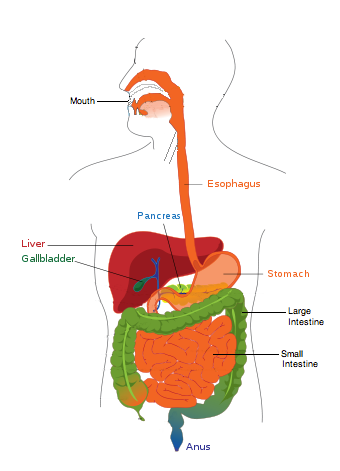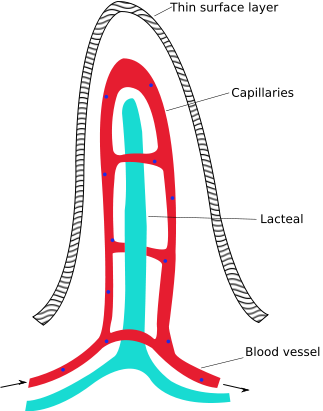Digestion
6.1.1 Explain why digestion of large food molecules is essential.
There are two reasons why the digestion of large food molecules is vital. Firstly, the food we eat is made up of many compounds made by other organisms which are not all suitable for human tissues and therefore these have to be broken down and reassembled so that our bodies can use them. Secondly, the food molecules have to be small enough to be absorbed by the villi in the intestine through diffusion, facilitated diffusion or active transport and so large food molecules need to be broken down into smaller ones for absorption to occur.
Summary:
- Food needs to be broken down and reassembled.
- Large food molecules need to be broken down into smaller ones.
6.1.2 Explain the need for enzymes in digestion.
Enzymes are needed in the process of digestion as they are the biological catalysts which break down the large food molecules into smaller ones so that these can eventually be absorbed. Digestion can occur naturally at body temperature, however this process takes a very long time as it happens at such a slow rate. For digestion to increase in these circumstances, body temperature would have to increase as well. However this is not possible as it would interfere with other body functions.This is why enzymes are vital as they speed up this process by lowering the activation energy required for the reaction to occur and they do so at body temperature.
Summary:
- Enzymes break down large food molecules into smaller ones.
- Speed up the process of digestion by lowering the activation energy for the reaction.
- Work at body temperature.
6.1.3 State the source, substrate, products and optimum pH conditions for one amylase, one protease and one lipase.
|
|
Amylase |
Protease |
Lipase |
|
Enzyme |
Salivary Amylase |
Pepsin |
Pancreatic Lipase |
|
Source |
Salivary Glands |
Chief cells in stomach lining |
Pancreas |
|
Substrate |
Starch |
Proteins |
Triglycerides such as fats and oils |
|
Products |
Maltose |
Small polypeptides |
Fatty Acids and Glycerol |
|
Optimum pH |
pH 7 |
pH 1.5 - 2 |
pH 7 |
6.1.4 Draw and label a diagram of the digestive system.

Figure 6.1.1 - The digestive system
6.1.5 Outline the function of the stomach, small intestine and large intestine.
The stomach is an important part of the digestive system. Firstly it secretes HCL which kills bacteria and other harmful organisms preventing food poisoning and it also provides the optimum conditions for the enzyme pepsin to work in (pH 1.5 - 2). In addition, the stomach secretes pepsin which starts the digestion of proteins into polypeptides and amino acids. Theses can then be absorbed by the villi in the small intestine.
The small intestine is where the final stages of digestion occur. The intestinal wall secretes enzymes and it also receives enzymes from the pancreas. However the main function of the small intestine is the absorption of the small food particles resulting from digestion. It contains many villi which increase the surface area for absorption.
The large intestine moves the material that has not been digested from the small intestine and absorbs water. This produces solid faeces which are then egested through the anus.
Summary:
Stomach:
- Secretes HCL which kills bacteria.
- HCL provides optimum pH for pepsin.
- Secretes pepsin for protein digestion.
Small intestine:
- Intestinal wall secretes enzymes
- Receives enzymes from the pancreas.
- Has villi for absorption of food particles.
Large intestine:
- Moves material that has not been digested along.
- Absorbes water.
- Produces faeces.
6.1.6 Distinguish between absorption and assimilation.
Absorption occurs when the food enters the body as the food molecules pass through a layer of cells and into the bodies tissues. This occurs in the small intestine which has many villi that are specialised for absorption. Assimilation occurs when the food molecules becomes part of the bodies tissue. Therefore, absorption is followed by assimilation.
6.1.7 Explain how the structure of the villus is related to its role in absorption and transport of the products of digestion.
The structure of the villus is very specific. Firstly there is a great number of them so this increases the surface area for absorption in the small intestine. In addition the villi also have their own projections which are called microvilli. The many microvilli increase the surface area for absorption further. These microvilli have protein channels and pumps in their membranes to allow the rapid absorption of food by facilitated diffusion and active transport. Also, the villi contains an epithelial layer which is only one cell layer thick so that food can pass through easily and be absorbed quickly. The blood capillaries in the villus are very closely associated with the epithelium so that the distance for the diffusion of the food molecules is small. This thin layer of cells contains mitochondria to provide the ATP needed for the active transport of certain food molecules. Finally, there is a lacteal branch at the centre of the villus which carries away fats after absorption.

Figure 6.1.2 - Intestinal villus
Summary:
- Many villi increase the surface area for absorption.
- Epithelium is only one cell layer thick and so food is quickly absorbed.
- Microvilli on the villi increase the surface area for absorption further.
- Protein channels and pumps are present in the microvilli for rapid absorption.
- The mitochondria in the epithelium provide ATP needed for active transport.
- Blood capillaries are very close to the epithelium so diffusion distance is small.
- The lacteal takes away fats after absorption.
